Why Rental Properties Are the Ultimate Passive Income Source
For decades, real estate has been one of the most reliable ways to generate passive income. Unlike stocks or bonds, property investing offers a dual advantage:
- Recurring monthly income through rent.
- Capital appreciation over time.
But owning property alone isn’t enough. The key to building sustainable passive income lies in choosing the right strategy, in the right location, with the right management model.
In this guide, Mohamed Akl reveals the 8 most effective passive income strategies through rental properties in 2025 tailored for both local and global investors.
1. Buy-and-Hold Residential Properties
The classic long-term rental model: buy a property, lease it out, and enjoy monthly cash flow + capital growth.
Best For:
- Investors seeking steady, predictable income.
- Buyers targeting mature neighborhoods with high demand.
Key Considerations:
- Focus on urban hubs, business districts, or university areas.
- Ensure cash flow covers mortgage, taxes, and maintenance, leaving monthly profit.
- Seek properties already tenanted or requiring minimal upgrades.
Example in Dubai: Al Furjan → Affordable entry + high occupancy.
2. Short-Term and Holiday Rentals
Platforms like Airbnb and Booking.com have transformed real estate income. Properly managed short-term rentals can earn 30–60% more than long-term leases.
Best For:
- Properties in tourism-heavy areas (Palm Jumeirah, Downtown, Dubai Marina).
- Investors outsourcing to holiday-home management companies.
Advantages:
- Seasonal demand spikes (events, winter tourism).
- Higher nightly rates.
- Flexibility for personal use + income.
3. Multi-Unit Residential Properties
Owning duplexes, triplexes, or small apartment buildings can maximize scale and efficiency.
Why it Works:
- Economies of scale → One roof, multiple tenants.
- Diversified income streams → Lower vacancy risk.
- Bulk deals → Developers often offer multi-unit packages.
Tip: Consider new master-planned communities for attractive entry prices.
4. Lease-to-Rent (Subletting Model)
Also known as rental arbitrage — leasing a property long-term, then re-letting short-term at a higher yield.
Requirements:
- Written landlord consent.
- Strong pricing & occupancy optimization skills.
- Professional cleaning & hospitality systems.
Note: This is semi-passive—requires setup, but can be systemized.
Read about Maximize Rental Yields in Dubai
5. Rent-to-Own Schemes
An innovative hybrid: tenants rent while contributing toward eventual ownership.
Investor Benefits:
- Higher monthly income (rent + premium).
- Tenant commitment (3–5 years).
- Reduced vacancy risk.
Risk Mitigation:
- Use legally binding agreements.
- Conduct thorough tenant vetting.
6. Invest in Ready-Furnished or Managed Units
Many developers now offer turnkey, fully managed rental properties.
Best For:
- Overseas investors seeking hands-off income.
- Entry-level buyers prioritizing simplicity & stability.
Advantages:
- Professional in-house management.
- Stable, predictable returns.
- Minimal time commitment.
Dubai Examples: Managed serviced apartments in Business Bay and Downtown.
Read more about Dubai Golden visa for investors
7. Commercial Property Leasing
Residential isn’t the only path. Commercial rentals (offices, retail, warehouses) offer long-term passive income with professional tenants.
High-Potential Areas:
- Business Bay → Office demand.
- Jebel Ali, Dubai Industrial City → Warehousing/logistics.
- Lifestyle communities → Retail spaces.
Why Commercial?
- Leases often last 3–10 years.
- Tenants cover many operational costs.
- Greater stability than residential.
8. Real Estate Syndicates and REITs
For maximum passivity, consider real estate syndications or REITs (Real Estate Investment Trusts).
Pros:
- Diversification across assets/geographies.
- Professionally managed.
- Regular dividend payouts.
In the UAE, several REITs specialize in income-producing properties, offering regulated, low-barrier entry.
Key Tips to Maximize Passive Rental Income
- Hire experienced property managers.
- Furnish for durability + lifestyle appeal (short-term units).
- Review service charges & hidden fees to calculate true net yield.
- Stay compliant with RERA, Ejari, and tax frameworks.
- Keep a maintenance reserve fund to avoid unexpected cash drains.
Final Thought: Passive Income = Freedom
Passive income through rental properties is not just about owning real estate—it’s about owning the right asset, in the right structure, with the right support.
When done strategically, rentals provide:
- Monthly income
- Long-term appreciation
- Financial freedom & time flexibility
As Mohamed Akl emphasizes, the true value of real estate isn’t just in wealth—it’s in the freedom it creates over time.
Global Reference: Knight Frank – Destination Dubai Real Estate Report
What type of rental property is best for passive income?
Buy-and-hold apartments in high-demand zones (like Dubai Marin, Business Bay) are the safest, while short-term holiday rentals can generate higher returns
Are short-term rentals more profitable than long-term rentals?
Yes—often 30–60% higher, especially in tourist areas. But they require professional management
Can foreigners invest in Dubai rental properties?
Yes—foreigners can own 100% freehold properties in designated areas and benefit from tax-free rental income
investing in commercial property better than residential?
Commercial properties offer longer lease terms and stability, but require higher upfront capital
What are REITs and how do they work?
REITs are regulated funds that pool investor money into income-generating real estate, paying out dividends without the need for direct property ownership
How do I calculate net rental yield?
Subtract service charges, maintenance, and management fees from gross rental income, then divide by purchase price






 100% Free Consultation
100% Free Consultation